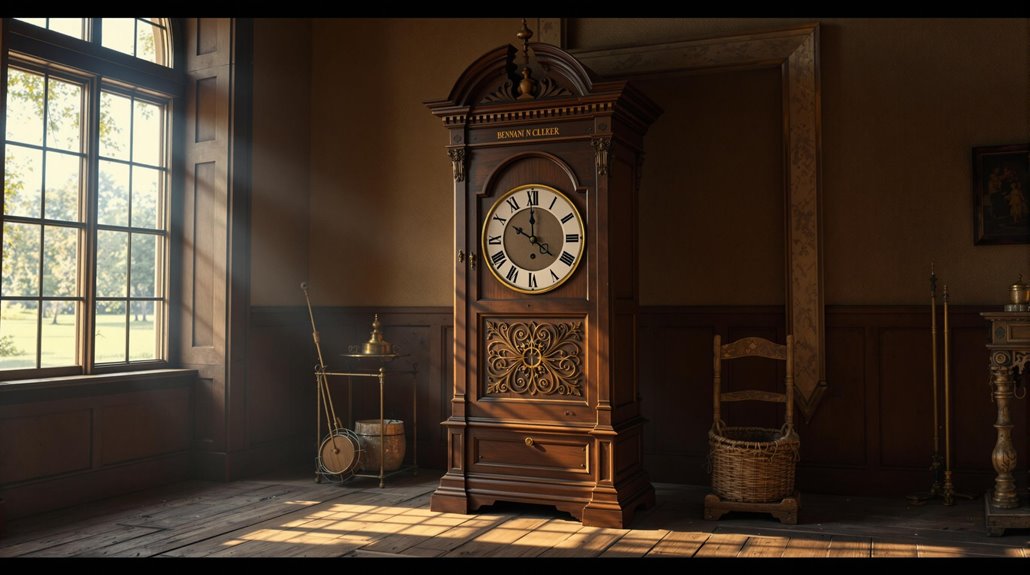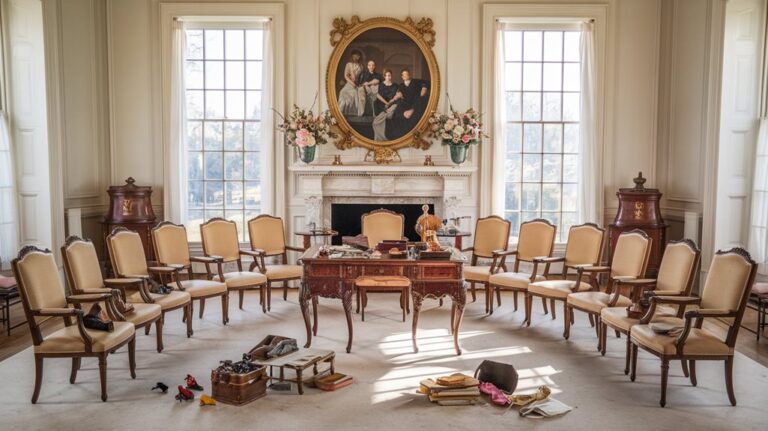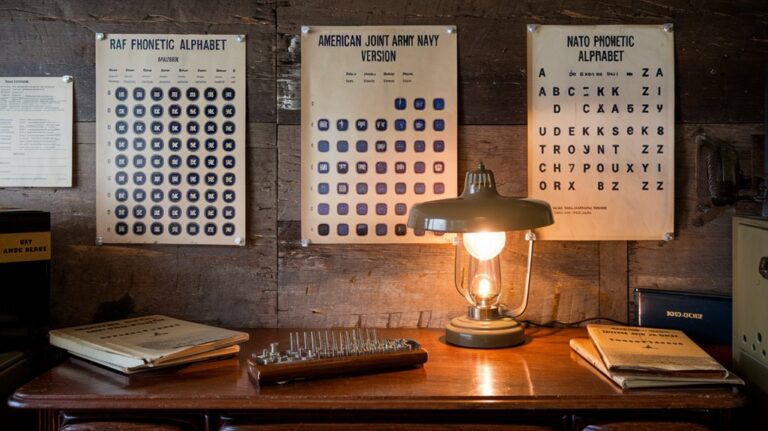Benjamin Banneker’s Tick-Tock Wonder: A Wooden Clock That Ran 40 Years
You've probably heard stories of remarkable inventions that changed history, but have you considered the tale of a wooden clock that kept perfect time for four decades? In colonial America, Benjamin Banneker crafted this engineering marvel using only local materials and his self-taught genius. What's even more intriguing is how a borrowed pocket watch sparked his journey from curious observer to innovative clockmaker. Let's explore how this groundbreaking timepiece challenged the limits of both engineering and society.
The Curious Mind Behind the Wooden Clock

Despite growing up with limited formal education, Benjamin Banneker's brilliant mind and insatiable curiosity drove him to become one of colonial America's most remarkable innovators.
His curiosity-driven nature emerged early, as his grandmother taught him reading and writing while he worked on his family's tobacco farm. You'll find that beyond his basic Quaker schooling, Banneker's self-taught mastery of mathematics and astronomy shaped his inventive spirit.
His sharp intellect didn't go unnoticed, as neighbors frequently sought his help with complex mathematical problems. This dedication to learning inspired him to share knowledge through his correspondence with Thomas Jefferson about civil rights.
While managing farm duties, he devoured borrowed textbooks on advanced mathematics and developed innovative irrigation systems.
This combination of practical knowledge and theoretical understanding would later enable him to create America's first wooden strike clock, marking the beginning of his legacy as a groundbreaking inventor.
From Pocket Watch to Wooden Marvel
When a wealthy neighbor lent Banneker a pocket watch in 1753, it sparked a remarkable journey of reverse engineering that would lead to his most famous invention.
You'd be amazed at how carefully he studied each component, taking the watch apart piece by piece and creating detailed diagrams of its mechanical parts. Unlike early pocket watches that used the verge escapement system, Banneker had to master a more complex mechanism.
With these drawings in hand, Banneker initiated an ambitious project: crafting a wooden clock from scratch.
He meticulously carved enlarged replicas of the pocket watch components, calculating the precise number of teeth needed for each gear and determining how they'd work together.
His attention to detail paid off spectacularly – the resulting timepiece wasn't just functional, it was a masterpiece that would chime every hour and keep perfect time for more than four decades.
Sadly, after keeping time accurately for over 50 years, the remarkable clock was destroyed in a devastating fire that consumed it.
Engineering Genius in Colonial America
Banneker's wooden clock exemplified the broader engineering ingenuity flourishing throughout Colonial America.
You'll find that engineering craftsmanship was essential for survival and progress in the colonies, from shipbuilding to printing presses. Colonial innovations weren't limited to mechanical devices – they transformed agriculture, communication, and urban development. Using his early self-taught education, Banneker mastered complex engineering principles that would later influence his remarkable inventions. The success of tobacco plantations relied heavily on mechanized innovations that improved efficiency and production.
Three ways engineering shaped Colonial America:
- Farmers applied STEM principles to create irrigation systems and improve crop yields.
- Shipbuilders developed advanced vessel designs that helped American merchants dominate maritime trade.
- Surveyors and architects like Banneker used mathematics and engineering to plan cities and infrastructure.
The colonies' rapid development relied on practical problem-solvers who, like Banneker, combined careful observation with technical skill to create lasting solutions for their communities.
A Timepiece That Made History
In 1753, a remarkable feat of engineering emerged from colonial America as a self-taught inventor crafted the nation's first striking clock made entirely from wooden parts.
Benjamin Banneker's timing techniques were revolutionary, as he meticulously studied a borrowed pocket watch, creating enlarged wooden replicas of each component.
You'll find that his historical craftsmanship proved extraordinary – the clock struck hours precisely and kept accurate time for over four decades until his death.
What's even more impressive is that he crafted it using only indigenous American materials.
While the original timepiece was tragically lost in a house fire, its legacy lives on.
Before creating his famous clock, Banneker had only attended two years of formal schooling, making his achievement even more remarkable.
Banneker's creation not only launched his successful clock repair business but also symbolized African American achievement in the 18th century, drawing visitors from across the colonies to marvel at his ingenuity.
Banneker's Clock: Inspiring Generations

Through his remarkable wooden clock, Benjamin Banneker's genius proved that talent knows no racial bounds in colonial America. His innovation legacy continues to inspire inventors, scientists, and dreamers who recognize that determination can overcome any obstacle.
You'll find his influence extends far beyond timekeeping, as his wooden masterpiece became a symbol of African American achievement and intellectual capability. Starting with a borrowed pocket watch, Banneker meticulously studied its mechanics to create his groundbreaking timepiece. His grandmother's teachings helped establish the educational foundation that made his innovations possible.
The educational impact of Banneker's clock resonates through centuries, teaching us:
- Self-education and curiosity can lead to groundbreaking discoveries
- Innovation doesn't require formal training or expensive materials
- One creation can challenge societal prejudices and open doors for others
The U.S. Postal Service's recognition of Banneker in 1980 commemorates not just his mechanical achievement, but his role in demonstrating that scientific genius transcends all social barriers.










